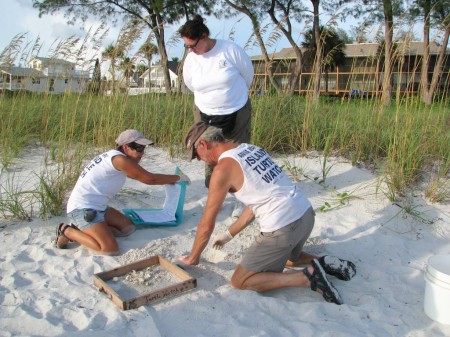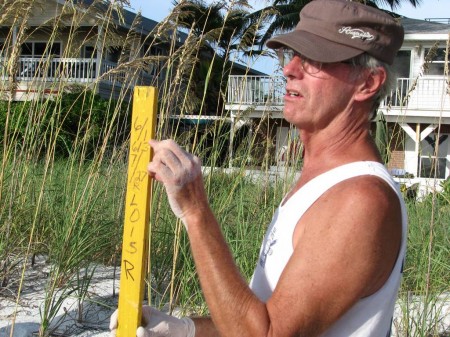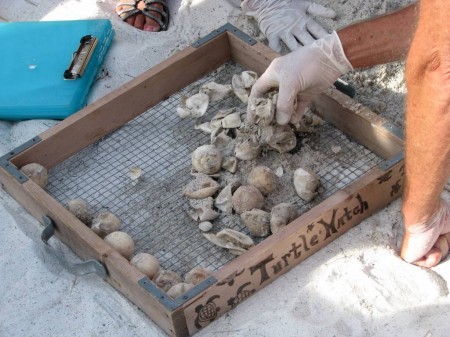
Suzi Fox, President of Anna Maria Island Turtle Watch, looks on as Ed and Betsy excavate a loggerhead turtle nest and carefully record their observations and measurements.
Posted by David McRee at BlogTheBeach.com
I recently spent some time on Holmes Beach, near 30th Avenue, with Suzi Fox and several dedicated Anna Maria Island Turtle Watch volunteers. The evening’s mission was to examine several turtle nests that had recently hatched to determine how successful the hatch was. This particular nest was originally deemed to be too close to the water’s edge, so the volunteers moved it higher up on the beach near the dune. 92 eggs were counted when the nest was moved. After excavation, 91 eggs were accounted for, 12 of which did not hatch. So this was a successful nest.
At the end of this article you can watch a short video clip of the excavation.

Ed explains what the numbers and letters stand for on the nest markers. These markers are helpful in keeping track of the nest location and the expected hatch date.
The loggerhead is the most common nesting sea turtle on Florida’s gulf coast. They nest during the summer months. The eggs generally take 55 to 65 days to hatch. The Anna Maria Island Turtle Watch volunteers walk the beach every morning, rain or shine, to locate and record all new turtle nests. They know when each nest is expected to hatch and keep a close eye on it for any activity.
If any homes near the beach have lights on at night the hatchling turtles will go toward the light instead of the water. They then get lost in the dunes and sea oats. Even one light bulb can throw a turtle hatchling off course. The volunteers do everything they can to make sure the turtles make the journey to the water and that beachfront property owners understand how important it is to have turtle-friendly lighting. This may seem like a bother to some, but I think it is a responsibility that must be borne by people who choose to live directly on the beach where their presence makes a greater impact on nature.
According to Suzi Fox, so far this 2009 season, Anna Maria has had 25 nests hatch with only 4 disorientations (hatchlings going away from the water instead of toward the water because of lights on beachfront properties). More than 160 nests have been recorded and the nesting season is not over yet.
Longboat Key, on the other hand, experiences disorientations in about 50 percent of their hatched nests because of all the lighting on beachfront properties.
The Pinellas County beaches have an even greater problem, to the point where they have to place cages around turtle nests that are nearing their hatch date to prevent the turtles from becoming disoriented by lighting. In case you’ve never been on a Pinellas County (St. Pete / Clearwater) beach after dark, the beachfront is lit up like Las Vegas. The sea turtle hatchlings don’t have a chance. The Clearwater Marine Aquarium monitors the turtle nests in Pinellas County.
Anna Maria used to cage 70 percent of its turtle nests, but since 1996 very little caging has been necessary because of lighting restrictions during turtle seasons combined with an education campaign. It seems that as the years go by more and more people are willing to cooperate to help bring the once plentiful sea turtles back to our beaches.
Amazing fact: When sea turtles reach adulthood and are ready to lay their eggs, they return to the beach where they were born.

Loggerhead sea turtle eggs are of a soft leathery consistency so they don't break when the turtle drops them into the nest hole. Here you can see some eggs that failed to hatch among the remains of eggs that did hatch.
Below is a very short video clip of the excavation.
Anna Maria Island Turtle Watch Volunteers in Action from David McRee on Vimeo.
If you think you’d like to get involved in the turtle activities on Anna Maria, visit the Anna Maria Turtle Watch website for more information:
Anna Maria Island Turtle Watch Website
The organization is also involved in shorebird nest monitoring and protection.



